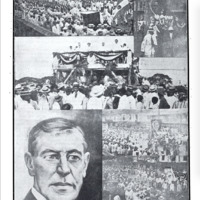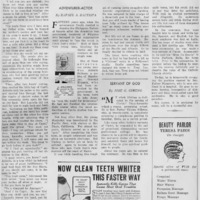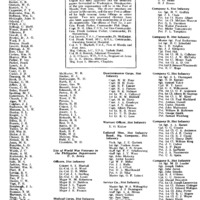Since the Philippines was an American territory, and the United States joined the war on April 6th, 1917, the Philippines was dragged to World War I (the Great War as it was known before 1939). According to the motto of US President Woodrow Wilson, the US were fighting for the rights of nations. Wilson, a defender of self-determination, was determined to end US colonial rule over the archipelago, and he in fact set in motion a more or less successful process of Filipinization of the administration (Tacujan 1997), which framed the impact of the conflict in the Philippines. It is not a surprise that his election was celebrated in the archipelago with an enthusiasm that suggests how Filipino participation in the great war was received.
In this context, and with independence seemingly within reach, the Philippines could prove their readiness by actively participating in the Great War. The UPD collection doesn’t hold much information on this topic, but it’s nevertheless necessary to highlight the active participation of the Philippines in the conflict, as Ricardo Trota Jose has brilliantly done in the International Encyclopedia of the First World War.
For example, the Philippines funded and built for the United States a destroyer that was laid down on 26 June 1918 in San Francisco. It was christened the USS Rizal, after the Philippines’ national hero, and would be the only US ship ever named after a Filipino (Jose 2021). As a token to the Philippines, the US Navy staffed it with a mainly Filipino crew.
One more thing the Philippines did for America during the Great War was the drafting of Filipinos for the US National Army. Militia Act, Act 2715, of 17th 1917 March provided for the creation of a Philippine National Guard (PNG), set off the American model, which would free American servicemen to fight overseas. This law created a problem, as Ricardo Jose argues (1988, 276-277) , for only states within the U.S. had the right to have militias. The raising of a PNG (the colonial government had the quota set at 15,000, but the Philippines provided 25,000) was, therefore, a way of showing both loyalty to the US. and preparedness for independence. Not without conflict, support for the PNG was widespread in US-colonial Philippines (Meixsel 2018, 40).
Nevertheless, questions regarding recruitment and also the loyalty of future Filipino-American soldiers arose, and it wasn't until January 19th, 1918 that the PNG Bill was passed by the American senate. The War Department worried that depleting the Philippines from American officers and personnel and the proliferation of militarized forces could be a problem for American control of the archipelago, as well as for public security and the usefulness of Filipino troops in a (mostly) European conflict (Jose 1988, 283-285). Most of these issues had racial and colonial undertones (Jose 1988; Meixsel 2018, 40, 42-43), which had to be negotiated between the American administration, either in the Philippines or on American territory, and the Philippine assembly. Finally, an Officer School and an Aero squadron were established and the PNG started its formation, although it would have to face constant recruitment issues from the beginning, especially for specialized jobs. Many towns were also incapable of raising the quota. For Jose (1988, 293-294), discrimination and lack of opportunities for the colonized Filipinos, especially within the officer ranks, was probably one of the reasons for these troubles. However, the PNG never saw action: mobilization was complemented only after November 11, 1918, when the armistice between the allies and their last remaining opponent, Germany, was signed.
After 19 February 1919, the PNG was demobilized. The Philippine Air Service continued on for two more years but was also disbanded. Nevertheless, thousands served on ships manned and operated by the US Navy and the British merchant marine. Details of their lives are sketchy, but we know names such as Private Tomas Claudio or Andres P. Dadizon. The UPD collection includes information about veterans of the PNG, such as Antonio Bollozos, who later joined the US navy and America’s quest to “save the world for democracy”, but also in order to go on an adventure. According to Graphic, “the brown boy”, who had served in an America’s ship, would end up as a “Chinese extra” in a Hollywood studio, changing his name to Tony Lee. Interestingly, in the fight for democracy.
Direct Filipino participation in the war was relatively minor, but Philippine involvement was manifested in other ways, such as providing materials for the war effort. As Vicente Angel S. Ybiernas (2007) explains, during the conflict the Philippines experimented with a true economic boom between 1916 and 1918, which made Gov.-Gen. Francis Burton Harrison (1913-1921) dream of achieving financial independence leading to political independence. Philippine exports increased due to the increasing demand and increase in prices: the value of Philippine trade grew by 40 percent from P230.9 million in 1916 to P322.8 million in 1917. The bulk of the country's trade, in peso value, came from and went to the United States (Ybiernas 2007, 355) Nevertheless, after the end of the First World War in 1918, when American consumers adopted the policy of "economic normalcy," the Philippine economy suffered a severe financial crisis due to devaluation and other factors, which exacerbated the lasting consequences of the war itself and the policies adopted during the Harrison administration and quick filipinization, which lead to inefficacy, corruption, and the strengthening of oligarchic rule, as argued by Priscilla Tacujan (1997, 23-28). The long-lasting consequences of this postwar crisis hindered talk of independence for years.
As Jose (2021) puts it, “The zeal in participating in the Great War was there, and the Philippine National Guard was organized to play its part. But the United States did not accept the offer until too late, and thus the PNG was unable to make its presence felt outside the Philippines”. Even though the UPD collection doesn't hold many publications of that period of time, the impact of WWI, as well as information on some of their protagonists, can be tracked down through the pages of these periodicals. In 1934, when the Tydings–McDuffie Act announced independence, hundreds of veterans of WWI (mostly Americans, but also Russians and Germans) were living in the archipelago and would, most probably, also face WWII in 1941.
Bibliographic references
Meixsel, Richard B. 2018. Frustrated Ambition: General Vicente Lim and the Philippine Military Experience, 1910-1944. Norman: University of Oklahoma Press.
Tacujan, Priscilla. 1997. “Is Philippine Democratization a Success? The Significance of Woodrow Wilson's Self-determination Policy”. Selected Papers in Asian Studies: Western Conference of the Association for Asian Studies, 62.
Trota Jose, Ricardo. 1988. “The Philippine National Guard in World War I.” Philippine Studies 36, no. 3, pp. 275–99.
---. 2021. "Philippines", in, 1914-1918-online. International Encyclopedia of the First World War (ed. by Ute Daniel, Peter Gatrell, Oliver Janz, Heather Jones, Jennifer Keene, Alan Kramer, and Bill Nasson), issued by Freie Universität Berlin, 2021-04-08.
Ybiernas, Vicente Angel S. 2007. “Philippine Financial Standing in 1921 The First World War Boom and Bust.” Philippine Studies 55/3, pp. 345–72.



